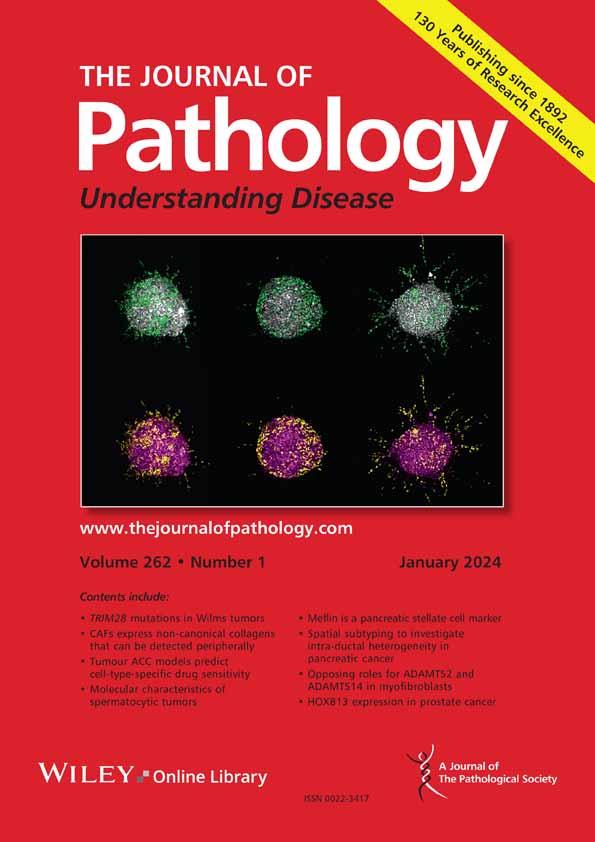Yujun Huang, Siyu Tu, Zhenni Xu, Lu Xu, Xi Wang, Hefei Tian, Qican He, Lingxiao Huang, Xudan Lei, Shubin Wang, Mingyue Qu, Dengqun Liu
求助PDF
{"title":"Loss of Mist1 alters the characteristics of Paneth cells and impacts the function of intestinal stem cells in physiological conditions and after radiation injury","authors":"Yujun Huang, Siyu Tu, Zhenni Xu, Lu Xu, Xi Wang, Hefei Tian, Qican He, Lingxiao Huang, Xudan Lei, Shubin Wang, Mingyue Qu, Dengqun Liu","doi":"10.1002/path.6360","DOIUrl":null,"url":null,"abstract":"<p>Intestinal stem cells (ISCs) and Paneth cells (PCs) reside at the bottom of the crypts of Lieberkühn in the small intestine. Recent studies have shown that the transcription factor Mist1, also named BHLHA15, plays an important role in the maturation of PCs. Since there is an intimate interaction between PCs and ISCs, we speculated that the loss of Mist1 could impact these two neighboring cell types. Here, we report that mice lacking Mist1 had fewer but larger PCs with shrunken secretory granules, accompanied by an increase in goblet cells and tuft cells. Mist1 loss significantly decreased the number of proliferative crypt cells, especially columnar basal cells (CBCs). In addition, Mist1-deficient enteroids needed supplemental Wnt3a to support their growth. Results from RNA sequencing (RNA-seq) demonstrated an apparent deficiency of innate immunity in Mist1-knockout mice. Intriguingly, Mist1 loss increased the survival rate of mice subjected to whole abdominal irradiation (WAI). Moreover, radiation injury was ameliorated in Mist1-knockout mice compared with their wild-type littermates based on histological analysis and enteroid culture, which might be a consequence of increased contents of the endoplasmic reticulum (ER) and the increased activity of mTORC1 in Paneth cells. In summary, our data uncover that Mist1 plays an important functional role in PCs and regulates the maintenance of ISCs and their response to radiation injury. © 2025 The Pathological Society of Great Britain and Ireland.</p>","PeriodicalId":232,"journal":{"name":"The Journal of Pathology","volume":"265 2","pages":"132-145"},"PeriodicalIF":5.2000,"publicationDate":"2025-01-03","publicationTypes":"Journal Article","fieldsOfStudy":null,"isOpenAccess":false,"openAccessPdf":"","citationCount":"0","resultStr":null,"platform":"Semanticscholar","paperid":null,"PeriodicalName":"The Journal of Pathology","FirstCategoryId":"3","ListUrlMain":"https://onlinelibrary.wiley.com/doi/10.1002/path.6360","RegionNum":2,"RegionCategory":"医学","ArticlePicture":[],"TitleCN":null,"AbstractTextCN":null,"PMCID":null,"EPubDate":"","PubModel":"","JCR":"Q1","JCRName":"ONCOLOGY","Score":null,"Total":0}
引用次数: 0
引用
批量引用
Abstract
Intestinal stem cells (ISCs) and Paneth cells (PCs) reside at the bottom of the crypts of Lieberkühn in the small intestine. Recent studies have shown that the transcription factor Mist1, also named BHLHA15, plays an important role in the maturation of PCs. Since there is an intimate interaction between PCs and ISCs, we speculated that the loss of Mist1 could impact these two neighboring cell types. Here, we report that mice lacking Mist1 had fewer but larger PCs with shrunken secretory granules, accompanied by an increase in goblet cells and tuft cells. Mist1 loss significantly decreased the number of proliferative crypt cells, especially columnar basal cells (CBCs). In addition, Mist1-deficient enteroids needed supplemental Wnt3a to support their growth. Results from RNA sequencing (RNA-seq) demonstrated an apparent deficiency of innate immunity in Mist1-knockout mice. Intriguingly, Mist1 loss increased the survival rate of mice subjected to whole abdominal irradiation (WAI). Moreover, radiation injury was ameliorated in Mist1-knockout mice compared with their wild-type littermates based on histological analysis and enteroid culture, which might be a consequence of increased contents of the endoplasmic reticulum (ER) and the increased activity of mTORC1 in Paneth cells. In summary, our data uncover that Mist1 plays an important functional role in PCs and regulates the maintenance of ISCs and their response to radiation injury. © 2025 The Pathological Society of Great Britain and Ireland.
Mist1的缺失改变了Paneth细胞的特性,影响了肠道干细胞在生理状态和辐射损伤后的功能。
小肠干细胞(ISCs)和潘氏细胞(PCs)位于小肠lieberk隐窝的底部。最近的研究表明,转录因子Mist1,也被称为BHLHA15,在PCs的成熟过程中起着重要作用。由于pc和ISCs之间存在密切的相互作用,我们推测Mist1的缺失可能会影响这两种相邻的细胞类型。在这里,我们报道缺乏Mist1的小鼠有更少但更大的PCs,分泌颗粒缩小,并伴有杯状细胞和簇状细胞的增加。Mist1缺失显著降低了增殖性隐窝细胞的数量,尤其是柱状基底细胞(CBCs)。此外,mist1缺陷肠需要补充Wnt3a来支持它们的生长。RNA测序(RNA-seq)结果显示,mist1基因敲除小鼠明显缺乏先天免疫。有趣的是,Mist1缺失增加了全腹照射(WAI)小鼠的存活率。此外,根据组织学分析和肠道培养,mist1敲除小鼠与野生型小鼠相比,辐射损伤得到了改善,这可能是Paneth细胞内质网(ER)含量增加和mTORC1活性增加的结果。综上所述,我们的数据揭示了Mist1在pc中发挥重要的功能作用,并调节ISCs的维持及其对辐射损伤的反应。©2024英国和爱尔兰病理学会。
本文章由计算机程序翻译,如有差异,请以英文原文为准。

 求助内容:
求助内容: 应助结果提醒方式:
应助结果提醒方式:


